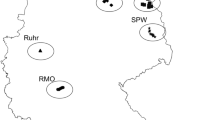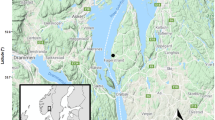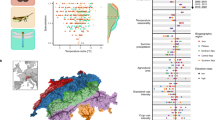Abstract
Populations of species fluctuate through time and across geographic space. Identifying the potential drivers of temporal variability in population dynamics is a fundamental aim of population ecology, with clear implications to understanding population extinction risk, the influence of diversity on composite community scale variability, and the extent to which temporal variability is driven by exogenous (e.g., climate) or endogenous (e.g., life history) factors. We used data from the National Ecological Observatory Network (NEON) consisting of over 750 carabid beetle species systematically sampled between 2013 and 2021 across 47 terrestrial sites in the USA to examine the relative roles of geographic location, environmental gradients, and species identity on temporal variability. We find an effect of species taxonomic identity on resulting temporal variability in abundance both at site-level and taxonomy-level scales. Environmental variables (mean annual temperature and precipitation and seasonality in temperature and precipitation) and geographic position (latitude and longitude) were not strongly related to temporal variability, and there was no spatial signal in site-level mean temporal variability. The importance of species to temporal variability highlights the role of life history differences across species, resulting in a mean shift in population growth rate, as a potentially more important driver than aspects of site and environment that may relate more to temporal changes in population growth rates.



Similar content being viewed by others
Data availibility
R code is available on figshare at https://doi.org/10.6084/m9.figshare.21217709. The NEON data should be cited directly if used, as NEON (National Ecological Observatory Network). Ground beetles sampled from pitfall traps, 2013–2021. https://doi.org/10.48443/tx5f-dy17. Dataset accessed from https://data.neonscience.org.
References
Arnoldi JF, Loreau M, Haegeman B (2019) The inherent multidimensionality of temporal variability: how common and rare species shape stability patterns. Ecol Lett 22(10):1557–1567
Bjørnstad ON, Grenfell BT (2001) Noisy clockwork: time series analysis of population fluctuations in animals. Science 293(5530):638–643
Boyce MS, Haridas CV, Lee CT, Group NSDW et al (2006) Demography in an increasingly variable world. Trends Ecol Evol 21(3):141–148
Brännström Å, Sumpter DJ (2005) The role of competition and clustering in population dynamics. Proc R Soc B Biol Sci 272(1576):2065–2072
Breton LM, Addicott JF (1992) Density-dependent mutualism in an aphid-ant interaction. Ecology 73(6):2175–2180
Chamberlain S, Szocs E (2013) taxize - taxonomic search and retrieval in R. F1000Research. http://f1000research.com/articles/2-191/v2
Chisholm RA, Condit R, Rahman KA, Baker PJ, Bunyavejchewin S, Chen YY, Chuyong G, Dattaraja H, Davies S, Ewango CE et al (2014) Temporal variability of forest communities: empirical estimates of population change in 4000 tree species. Ecol Lett 17(7):855–865
Clark AT, Arnoldi JF, Zelnik YR, Barabas G, Hodapp D, Karakoç C, König S, Radchuk V, Donohue I, Huth A et al (2021) General statistical scaling laws for stability in ecological systems. Ecol Lett 24(7):1474–1486
Dallas T, Melbourne BA, Legault G, Hastings A (2021) Initial abundance and stochasticity influence competitive outcome in communities. J Anim Ecol 90(7):1691–1700
Dallas TA, Kramer AM (2022) Temporal variability in population and community dynamics. Ecology 103(2):e03577
Den Boer P (1970) On the significance of dispersal power for populations of carabid-beetles (Coleoptera, Carabidae). Oecologia 4(1):1–28
Ergon T, Lambin X, Stenseth NC (2001) Life-history traits of voles in a fluctuating population respond to the immediate environment. Nature 411(6841):1043–1045
Fernández-Martínez M, Vicca S, Janssens IA, Carnicer J, Martín-Vide J, Peñuelas J (2018) The consecutive disparity index, D: a measure of temporal variability in ecological studies. Ecosphere 9(12)
Forcada J, Trathan PN, Murphy EJ (2008) Life history buffering in Antarctic mammals and birds against changing patterns of climate and environmental variation. Glob Change Biol 14(11):2473–2488
Fountain-Jones NM, Baker SC, Jordan GJ (2015) Moving beyond the guild concept: developing a practical functional trait framework for terrestrial beetles. Ecol Entomol 40(1):1–13
Hakspiel-Segura C, Martínez-López A, Delgado-Contreras JA, Robinson CJ, Gómez-Gutiérrez J (2022) Temporal variability of satellite chlorophyll-a as an ecological resilience indicator in the central region of the gulf of California. Progress in Oceanography p 102825
Hart EM, Bell K (2015) prism: download data from the Oregon prism project. https://doi.org/10.5281/zenodo.33663, https://github.com/ropensci/prism, r package version 0.0.6
Hijmans RJ (2021) geosphere: spherical trigonometry. https://CRAN.R-project.org/package=geosphere. r package version 1.5-14
Hudson PJ, Newborn D, Dobson AP (1992) Regulation and stability of a free-living host-parasite system: Trichostrongylus tenuis in red grouse. i. monitoring and parasite reduction experiments. J Anim Ecol pp 477–486
Inchausti P, Halley J (2002) The long-term temporal variability and spectral colour of animal populations. Evol Ecol Res 4(7):1033–1048
Kao RH, Gibson CM, Gallery RE, Meier CL, Barnett DT, Docherty KM, Blevins KK, Travers PD, Azuaje E, Springer YP et al (2012) Neon terrestrial field observations: designing continental-scale, standardized sampling. Ecosphere 3(12):1–17
Kareiva P (1990) Population dynamics in spatially complex environments: theory and data. Philos Trans R Soc Lond B Biol Sci 330(1257):175–190
Koons DN, Pavard S, Baudisch A, Metcalf Jessica EC (2009) Is life-history buffering or lability adaptive in stochastic environments? Oikos 118(7):972–980
Krebs CJ (2013) Population fluctuations in rodents. In: Population Fluctuations in Rodents, University of Chicago Press
Kremer CT, Fey SB, Arellano AA, Vasseur DA (2018) Gradual plasticity alters population dynamics in variable environments: thermal acclimation in the green alga Chlamydomonas reinhartdii. Proc R Soc B Biol Sci 285(1870):20171942
Le Coeur C, Yoccoz NG, Salguero-Gómez R, Vindenes Y (2022) Life history adaptations to fluctuating environments: combined effects of demographic buffering and lability. Ecol Lett 25(10):2107–2119
Lövei GL, Sunderland KD (1996) Ecology and behavior of ground beetles (Coleoptera: Carabidae). Ann Rev Entomol 41(1):231–256
Lundberg P, Ranta E, Ripa J, Kaitala V (2000) Population variability in space and time. Trends Ecol Evol 15(11):460–464
Majeková M, de Bello F, Doležal J, Lepš J (2014) Plant functional traits as determinants of population stability. Ecology 95(9):2369–2374
Marrec R, Caro G, Miguet P, Badenhausser I, Plantegenest M, Vialatte A, Bretagnolle V, Gauffre B (2017) Spatiotemporal dynamics of the agricultural landscape mosaic drives distribution and abundance of dominant carabid beetles. Landsc Ecol 32:2383–2398
Martin J, Royle JA, Mackenzie DI, Edwards HH, Kery M, Gardner B (2011) Accounting for non-independent detection when estimating abundance of organisms with a Bayesian approach. Methods Ecol Evol 2(6):595–601
McCann KS (2000) The diversity-stability debate. Nature 405(6783):228–233
Melbourne BA, Hastings A (2008) Extinction risk depends strongly on factors contributing to stochasticity. Nature 454(7200):100
Meseguer-Ruiz O, Olcina Cantos J, Sarricolea P, Martín-Vide J (2017) The temporal fractality of precipitation in mainland Spain and the Balearic islands and its relation to other precipitation variability indices. Int J Climatol 37(2):849–860
Niemelä J (2001) Carabid beetles (Coleoptera: Carabidae) and habitat fragmentation: a review. Eur J Entomol 98(2):127–132
Oro D (2013) Grand challenges in population dynamics. Front Ecol Evol 1:2
Ovaskainen O, Cornell SJ (2006) Space and stochasticity in population dynamics. Proc Nat Acad Sci 103(34):12781–12786
Ovaskainen O, Meerson B (2010) Stochastic models of population extinction. Trends Ecol Evol 25(11):643–652
Pironon S, Papuga G, Villellas J, Angert AL, García MB, Thompson JD (2017) Geographic variation in genetic and demographic performance: new insights from an old biogeographical paradigm. Biol Rev 92(4):1877–1909
Pironon S, Villellas J, Thuiller W, Eckhart VM, Geber MA, Moeller DA, García MB (2018) The Hutchinsonian niche as an assemblage of demographic niches: implications for species geographic ranges. Ecography 41(7):1103–1113
Pizzolotto R, Mazzei A, Bonacci T, Scalercio S, Iannotta N, Brandmayr P (2018) Ground beetles in Mediterranean olive agroecosystems: their significance and functional role as bioindicators (Coleoptera, Carabidae). PloS one 13(3)
PRISM Climate Group (2023) Oregon state university, https://prism.oregonstate.edu. Data created 4 Feb 2014, Accessed Jan 2023
Rainio J, Niemelä J (2003) Ground beetles (Coleoptera: Carabidae) as bioindicators. Biodivers Conserv 12(3):487–506
Revell LJ (2012) phytools: an R package for phylogenetic comparative biology (and other things). Methods Ecol Evol 3:217–223
Sprössig C, Dziock F, Buchholz S (2022) Changes in carabid diversity indicate successful restoration of riparian habitats. Int Rev Hydrobiol 107(1–2):68–75
Tilman D, Lehman CL, Bristow CE (1998) Diversity-stability relationships: statistical inevitability or ecological consequence? Am Nat 151(3):277–282
Tuljapurkar S (1982) Population dynamics in variable environments. ii. correlated environments, sensitivity analysis and dynamics. Theor Popul Biol 21(1):114–140
Tuljapurkar S (1989) An uncertain life: demography in random environments. Theor Popul Biol 35(3):227–294
Tuljapurkar S (2013) Population dynamics in variable environments, vol 85. Springer Science & Business Media
Vergotti M, Fernández-Martínez M, Kefauver S, Janssens I, Peñuelas J (2019) Weather and trade-offs between growth and reproduction regulate fruit production in European forests. Agric For Meteorol 279
Wang S, Haegeman B, Loreau M (2015) Dispersal and metapopulation stability. PeerJ 3:e1295
Acknowledgements
The National Ecological Observatory Network is a program sponsored by the National Science Foundation and operated under a cooperative agreement by Battelle. This material is based in part upon work supported by the National Science Foundation through the NEON Program. This work benefited greatly from conversations with Carl Boettiger.
Funding
This work has been performed with funding to Tad Dallas from the National Science Foundation (NSF-DEB-2017826) Macrosystems Biology and NEON-Enabled Science program.
Author information
Authors and Affiliations
Contributions
Tad Dallas performed the analysis and wrote the initial draft. Cleber Ten Caten and Lauren Holian helped form the initial idea, provided feedback on analysis, and contributed to manuscript writing and editing.
Corresponding author
Ethics declarations
Competing interests
The authors declare no competing interests.
Supplementary Information
Below is the link to the electronic supplementary material.
Rights and permissions
Springer Nature or its licensor (e.g. a society or other partner) holds exclusive rights to this article under a publishing agreement with the author(s) or other rightsholder(s); author self-archiving of the accepted manuscript version of this article is solely governed by the terms of such publishing agreement and applicable law.
About this article
Cite this article
Dallas, T.A., Caten, C.T. & Holian, L.A. Temporal variability of carabid beetles as a function of geography, environment, and species. Theor Ecol 17, 35–43 (2024). https://doi.org/10.1007/s12080-023-00573-1
Received:
Accepted:
Published:
Issue Date:
DOI: https://doi.org/10.1007/s12080-023-00573-1




